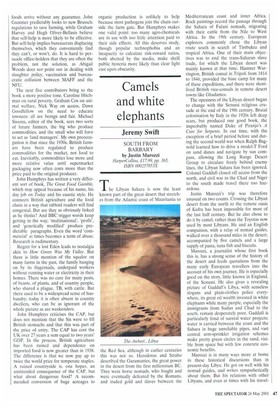Camels and white elephants
Jeremy Swift
SOUTH FROM BARBARY by Justin Marozzi HarperCollins, £17.99, pp. 365, ISBN 000257053X The Libyan Sahara is now the least known part of the great desert that stretches from the Atlantic coast of Mauritania to Mediterranean coast and inner Africa. Rock paintings record the passage through the Sahara of Fulani nomads, migrating with their cattle from the Nile to West Africa. In the 19th century, European explorers commonly chose the Libyan route south in search of Timbuktu and tropical Africa. One of their main objectives was to end the trans-Saharan slave trade, for which the Libyan desert was mainly known at that time. Hanmer Warrington, British consul in Tripoli from 1814 to 1846, provided the base camp for many of these expeditions, and there were shortlived British vice-consuls in remote desert towns like Ghadames.
The openness of the Libyan desert began to change with the Senussi religious crusade at the end of the 19th century. Brutal colonisation by Italy in the 1920s left deep scars, but produced one good book, the improbably named Duke of Piranjo's A Cure for Serpents. In our time, with the exception of a brief period before and during the second world war when Ralph Bagnold learned how to drive a model-T Ford on sand dunes and navigate by sun compass, allowing the Long Range Desert Group to circulate freely behind enemy lines, the Libyan Sahara has been ignored. Colonel Gaddafi closed off access from the north, and civil war in the Chad and Niger to the south made travel there too hazardous.
Justin Marozzi's trip was therefore unusual on two counts. Crossing the Libyan desert from the north to the remote oasis of Kufra has been impossible for most of the last half century. But he also chose to do it by camel, rather than the Toyotas now used by most Libyans. He and an English companion, with a relay of nomad guides, walked over a thousand miles in the desert, accompanied by five camels and a large supply of pasta, tuna fish and biscuits.
Marozzi, a journalist whose first book this is, has a strong sense of the history of the desert and feeds quotations from the many early European travellers into the account of his own journey. He is especially good on the story, little known in England, of the Senussi. He also gives a revealing picture of Gaddafi's Libya, with senseless slogans and plain-clothes police everywhere, its great oil wealth invested in white elephants while many people, especially the immigrants from Sudan and Chad to the south, remain desperately poor. Gaddafi is particularly fond of surreal water projects: water is carried between the coast and the Sahara in huge unreliable pipes, and vast central arm-sprinkler irrigation schemes make pretty green circles in the sand, visible from space but with few concrete economic benefits.
Marozzi is in many ways more at home in these historical discursions than in present-day Libya. He got on well with his nomad guides, and writes sympathetically about them. But his relations with other Libyans, and even at times with his travel ling companion, were strained. He was naïve in his dealings with the authorities, setting off on foot across the desert without his passport and behaving arrogantly with policemen doing their job. Officials were — as officials are — quite tiresome, and Marozzi was quite tiresome back. It's not a good way to travel in remote places unused to Westerners. The result was that he did not see much from a local perspective, and remains most of the time an Englishman abroad, keeping his distance from and belittling many of the people he meets.
Is it essential for travellers in exotic places to try to place themselves, at least some of the time, in the minds of those travelled among? The best accounts do; think of books by Colin Thubron and Michael Asher, or television by Michael Palin. This does not exclude some funpoking, preferably as much at oneself as at others. But sniping at tiresome foreigners is not an interesting or rewarding position for a writer for very long.



















































































 Previous page
Previous page